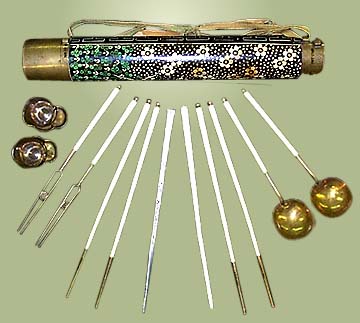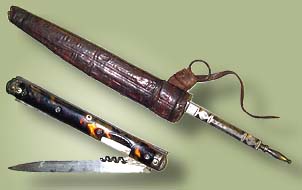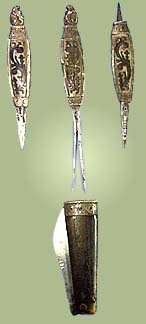


Because people must eat no matter where they are, there has long been a need for portable eating utensils. Throughout history, nomads, wealthy travelers, and soldiers fighting abroad have all used cutlery with which they could easily travel, as illustrated above.
 Portable
multi-purpose knives have been used for hunting, eating, and defense since prehistoric
times. Frontiersmen, explorers, travelers, hunters, and soldiers have all required
knives for survival and food procurement, and they have all found ways of making
knives portable, whether it was storing them in sheaths at the belt, like the
knife to the left, or in their stockings.
Portable
multi-purpose knives have been used for hunting, eating, and defense since prehistoric
times. Frontiersmen, explorers, travelers, hunters, and soldiers have all required
knives for survival and food procurement, and they have all found ways of making
knives portable, whether it was storing them in sheaths at the belt, like the
knife to the left, or in their stockings.
CAS 0389-1901A,B:
19th C. Southern European sheathed knife (above)
CAS
0389-1917: 18th C. French pocket knife (below)
A folding pocket knife, perhaps the consummately portable multipurpose tool, was first made in the 1st Century by the Romans to be used on journeys of exploration or conquest. As the popularity of sheathed knives grew, the manufacture of pocket knives waned. By the late 16th Century, however, pocket knives began to regain popularity especially in America. Unlike sheathed knives, which were generally conspicuous and sometimes cumbersome, pocket knives were easily, safely, and invisibly carried in the pocket like the knife on the left. Men of all trades, from farmers to academics, carried pocket knives to aid in various tasks, including eating on the go.
Pocket knives have
also been important tools of survival for soldiers. New York and New Hampshire
required their militias to carry pocket knives during the American Revolutionary
War, and the U.S. Navy issued pocket knives to sailors as early as the Civil
War. Even during World War II, pocket knives were issued to American  soldiers,
sailors, and marines.
soldiers,
sailors, and marines.
CAS 0389-1913A-D: 16th C. German folding knife with cutlery (right)
While knives and pocket knives could be used for tasks other than eating, portable cutlery used exclusively for dining was also created, as can be seen in the set to the right.
CAS 0389-1675:
English folding fork (top)
CAS 0389-2037: American folding spoon (center)
CAS 0389-1669: 18th C. French folding fork (bottom)
During the 15th Century, European nobles often carried utensils with them when traveling because many inns did not provide guests with cutlery. Knife and fork sets that fit into sheaths and attached at the belt became popular. Often knives, forks, or spoons like those to the left could be folded or had interlocking handles that could fit into small traveling pouches and attached to a belt. Pocket spoon and fork combinations were also made, some with folding forks whose tines slid into loops on the back of a detachable spoon bowl. In America, particularly during the Civil War, combination folding knife/fork/spoons were widely sold.
Chopsticks have
also been transformed into portable eating utensils. In pre-Modern Japan, members
of the military class traveled and carried portable eating sets containing chopsticks
and a knife that could fit in their obi (sash).
CAS 0389-1940A-C:
Mongolian eating set (below)


CAS
0389-1937A-D: Japanese travel chopstick/ knife set (left)
CAS 0389-1934A-D: Japanese travel chopstick/ knife set (three items to right)
It was also necessary for nomads such as the Mongolians to have easy-to-carry eating sets, like the one to the left. Because Mongolians usually wore a pocketless garment called a del, they attached eating sets containing chopsticks and a knife to a sash. A silver loop attached to the end of a chord locked the knife and chopsticks in place so they did not fall out if the owner;was active or on horseback.